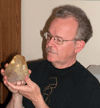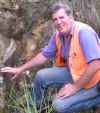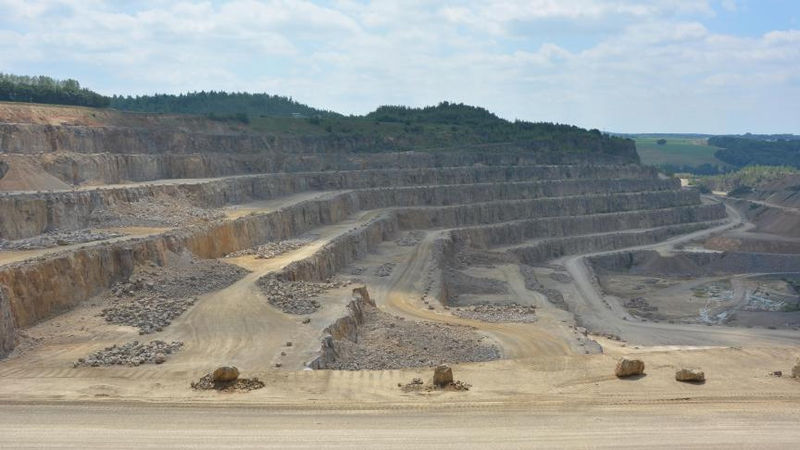| View previous topic :: View next topic |
| Author |
Message |
James Catmur
Site Admin

Joined: 14 Sep 2006
Posts: 1396
Location: Cambridge



|
 Posted: Nov 24, 2023 05:14 Post subject: Dissolution enables dolomite crystal growth near ambient conditions Posted: Nov 24, 2023 05:14 Post subject: Dissolution enables dolomite crystal growth near ambient conditions |
|
|
An interesting article about speed of growth of Dolomite and how to increase it at ambient conditions
https://www.science.org/doi/10.1126/science.adi3690
(link normalized by FMF)
|
|
| Back to top |
|
 |
marco campos-venuti

Joined: 09 Apr 2014
Posts: 208
Location: Sevilla



|
 Posted: Nov 24, 2023 07:27 Post subject: Re: Dissolution enables dolomite crystal growth near ambient conditions Posted: Nov 24, 2023 07:27 Post subject: Re: Dissolution enables dolomite crystal growth near ambient conditions |
|
|
The "dolomite problem" does not refer to the difficulty of growing crystals in the laboratory, but to its abundance in nature in low temperature environments since dolomite crystallizes in hydrothermal systems at temperatures higher than 100 °C. This ancient geological problem was solved years ago when it was understood that dolomite precipitates thanks to the presence of a bacterial fauna (Vasconcelos et al, 1995). So the mechanism by cycling the solution does not solve the dolomite problem at all. The authors simply discovered a trick to precipitate dolomite in the laboratory.
Vasconcelos, C., McKenzie, J. A., Bernasconi, S., Grujic, D., & Tiens, A. J. (1995). Microbial mediation as a possible mechanism for natural dolomite formation at low temperatures. Nature, 377(6546), 220-222.
|
|
| Back to top |
|
 |
Roger Warin

Joined: 23 Jan 2013
Posts: 1193



|
 Posted: Nov 24, 2023 08:03 Post subject: Re: Dissolution enables dolomite crystal growth near ambient conditions Posted: Nov 24, 2023 08:03 Post subject: Re: Dissolution enables dolomite crystal growth near ambient conditions |
|
|
| This reminds me of the opposite sequence in an Oregon lake!
|
|
| Back to top |
|
 |
James Catmur
Site Admin

Joined: 14 Sep 2006
Posts: 1396
Location: Cambridge



|
 Posted: Nov 24, 2023 08:27 Post subject: Re: Dissolution enables dolomite crystal growth near ambient conditions Posted: Nov 24, 2023 08:27 Post subject: Re: Dissolution enables dolomite crystal growth near ambient conditions |
|
|
I am not sure 'possible'='solved' but adds to the discussion. Thank you
https://www.nature.com/articles/377220a0
(link normalized by FMF)
| marco campos-venuti wrote: | The "dolomite problem" does not refer to the difficulty of growing crystals in the laboratory, but to its abundance in nature in low temperature environments since dolomite crystallizes in hydrothermal systems at temperatures higher than 100 °C. This ancient geological problem was solved years ago when it was understood that dolomite precipitates thanks to the presence of a bacterial fauna (Vasconcelos et al, 1995). So the mechanism by cycling the solution does not solve the dolomite problem at all. The authors simply discovered a trick to precipitate dolomite in the laboratory.
Vasconcelos, C., McKenzie, J. A., Bernasconi, S., Grujic, D., & Tiens, A. J. (1995). Microbial mediation as a possible mechanism for natural dolomite formation at low temperatures. Nature, 377(6546), 220-222. |
|
|
| Back to top |
|
 |
Pete Richards
Site Admin

Joined: 29 Dec 2008
Posts: 833
Location: Northeast Ohio



|
 Posted: Nov 24, 2023 10:10 Post subject: Re: Dissolution enables dolomite crystal growth near ambient conditions Posted: Nov 24, 2023 10:10 Post subject: Re: Dissolution enables dolomite crystal growth near ambient conditions |
|
|
I think it is appropriate to ask "what really is The Dolomite Problem"? I think the term is attractive enough and vague enough that different people may have different answers because they interpret the question differently.
A quick search of the web led to a recent paper by C.M. Pena and others, which states: "Dolomite, CaMg(CO3)2, is an abundant carbonate mineral in ancient rock formations, but it is extremely scarce in modern sedimentary environments. This intriguing observation has been repeatedly referred to as the “dolomite problem” in the geological literature." I do not cite this to establish "the" correct answer to this question, but to suggest that we as mineral collectors may be misunderstanding what at least some geologists have meant by the question.
I think the meaning of dolomite in this question may not be the nice rhombohedral crystals we find in vugs in various geological environments, but the large expanses of dolomite rock - dolostone - which are found in the sedimentary record. These are composed of interlocked sand-sized and finer grains of dolomite in crystals too small to see with the eye and too intergrown to be of much interest to mineral collectors. Dolostones are very often quite porous, which is not insignificant.
In this context, one answer to the dolomite question is that the dolomite of these dolostones formed by slow replacement of original calcite (limestone) either during diagenesis or later. Some would say dolostones are old because the replacement process takes a long time at geologically modest temperatures, especially the ordering of calcium and magnesium in the crystal lattice necessary to form true dolomite. An intersesting point here is that the one-for-one replacement of calcite "molecules" by dolomite molecules involves a decrease in volume, and can explain the porosity typical of dolostones.
Like many aspects of geology, questions like this one can be understood in a number of different ways, each of which may have several different plausible (and sometimes incomplete) answers!
_________________
Collecting and studying crystals with interesting habits, twinning, and epitaxy |
|
| Back to top |
|
 |
marco campos-venuti

Joined: 09 Apr 2014
Posts: 208
Location: Sevilla



|
 Posted: Nov 24, 2023 11:16 Post subject: Re: Dissolution enables dolomite crystal growth near ambient conditions Posted: Nov 24, 2023 11:16 Post subject: Re: Dissolution enables dolomite crystal growth near ambient conditions |
|
|
Pete I have to contradict you. Your explanation of the replacement of calcite by dolomite during diagenesis was the ancient solution to the origin of dolomite formations such as the Dolomite Mountains (1 km thick without one single crystal of calcite remain). Numerous pieces of evidence have always contradicted this hypothesis and this was the "Dolomite problem". Today it is known that dolomite precipitates as a primary mineral thanks to the binding of the Mg2+ ion on bacterial EPS (Extracellular polymeric substance). Numerous well-documented cases of primary dolomite associated with bacterial faunas in sabkha environments are known.
Bontognali, T. R. (2019). Anoxygenic phototrophs and the forgotten art of making dolomite. Geology, 47(6), 591-592.
|
|
| Back to top |
|
 |
Kevin Schofield

Joined: 05 Jan 2018
Posts: 163
Location: Beacon NY


|
 Posted: Nov 24, 2023 11:56 Post subject: Re: Dissolution enables dolomite crystal growth near ambient conditions Posted: Nov 24, 2023 11:56 Post subject: Re: Dissolution enables dolomite crystal growth near ambient conditions |
|
|
| marco campos-venuti wrote: | Pete I have to contradict you. Your explanation of the replacement of calcite by dolomite during diagenesis was the ancient solution to the origin of dolomite formations such as the Dolomite Mountains (1 km thick without one single crystal of calcite remain). Numerous pieces of evidence have always contradicted this hypothesis and this was the "Dolomite problem". Today it is known that dolomite precipitates as a primary mineral thanks to the binding of the Mg2+ ion on bacterial EPS (Extracellular polymeric substance). Numerous well-documented cases of primary dolomite associated with bacterial faunas in sabkha environments are known.
Bontognali, T. R. (2019). Anoxygenic phototrophs and the forgotten art of making dolomite. Geology, 47(6), 591-592. |
It has, admittedly, been a while since I completed my PhD on dolomitization in the Carboniferous in Central England, but I don't believe that it constitutes entirely "ancient" history.
Dolomites in the geological record comprise three "families".
Those formed early in association with peritidal environments (such as the sabkhas mentioned above) where biological mediation is important and primary dolomite may be precipitated. This setting is complex, and also has dolomite formed very early burial, where there is an association with the mixing zone between marine and fresh waters, where it is associated with very particular water salinities/chemistries (for the interested, there is an abundant literature on mixing zone dolomitization, for example in the lagoons of Bonaire in the Netherlands Antilles). Peritidal carbonates are (by the very nature of the "carbonate factory") not unusual, but cannot account for the great thicknesses of dolomite found in the geological record.
There we must look to the mass replacement of calcium carbonate by calcium magnesium carbonate during burial. In my particular field area, petrographic evidence showed a full transition series from somewhat dolomitized, thoroughly recrystallized limestones to 100% dolomite. Subsequent isotope analysis showed this to have happened at moderate temperatures (less than 100 degrees celcius), with the likely sources of diagentetic fluids being dewatering of shales in the basins adjacent to the carbonate platform. There remains a possibility that uplift and erosion during the Permian may also have been a factor in this individual case.
The third corm of dolomite is the high temperature polymorph "saddle dolomite" formed in association with hydrothermal diagenesis associated with fluids expelled from deep in the earth up faults and often associated with ore mineralization.
In conclusion, I would say that there isn't really a "dolomite problem". You just have to do the work to figure out which mode of diagenesis (and occasionally primary precipitation) was responsible.
_________________
Veni, Vidi, Emi |
|
| Back to top |
|
 |
Linus

Joined: 06 Nov 2015
Posts: 60
Location: Tucson


|
 Posted: Nov 24, 2023 15:48 Post subject: Re: Dissolution enables dolomite crystal growth near ambient conditions Posted: Nov 24, 2023 15:48 Post subject: Re: Dissolution enables dolomite crystal growth near ambient conditions |
|
|
| I like to hear of your three methods of dolomite formation. I'm particularly a fan and supporter of the third method you describe, which I have seen in the field in several important mineral districts - places where a dolomite "front" can be mapped on the scale of 100's of meters, often immediately peripheral to ore-mineral deposition. I know of many geologists who simply write off dolomite presence as a regional effect and I strongly believe that this is not always correct.
|
|
| Back to top |
|
 |
Roger Warin

Joined: 23 Jan 2013
Posts: 1193



|
 Posted: Nov 24, 2023 16:37 Post subject: Re: Dissolution enables dolomite crystal growth near ambient conditions Posted: Nov 24, 2023 16:37 Post subject: Re: Dissolution enables dolomite crystal growth near ambient conditions |
|
|
The Marche-les-Dames dolomite deposit is one of the purest in the world. However, the composition of the rock is not homogeneous.
| Description: |
|
| Viewed: |
7508 Time(s) |

|
|
|
| Back to top |
|
 |
Kevin Schofield

Joined: 05 Jan 2018
Posts: 163
Location: Beacon NY


|
 Posted: Nov 27, 2023 11:28 Post subject: Re: Dissolution enables dolomite crystal growth near ambient conditions Posted: Nov 27, 2023 11:28 Post subject: Re: Dissolution enables dolomite crystal growth near ambient conditions |
|
|
Following on from my post above, by an odd coincidence an article came up on my LinkedIn feed, pointing out the cover article from the magazine SCIENCE VOLUME 382| ISSUE 6673|24 NOV 2023 entitled "The Dolomite Problem. Resolving an epic geologic mystery".
The short LI abstract says:
Dolomite (CaMg(CO3)2) is a key mineral in stunning geological formations like the Dolomite mountains, Niagara Falls, and Hoodoos (those funny rock-capped spires in Utah). However, Dolomite is essentially impossible to grow in the laboratory. The abundance of dolomite in nature, coupled with its inability to be grown in the lab, is an apparent contradiction that has stymied scientists for over 200 years.
I am pleased that our work in resolving the Dolomite problem was published today as a cover article in Science. ( https://lnkd.in/grPrxE8W [link normalized by FMF]). Not only did we explain why Dolomite can't be grown in the lab, we also explained how Dolomite forms in nature, and furthermore, directly grew Dolomite in a liquid-cell electron microscope for the first time.
The mechanism is counterintuitive--in order to grow dolomite, you first have to *dissolve* it. This dissolution eliminates Ca/Mg disorder which blocks further crystal growth. In nature, Dolomite forms where there are frequent rain or tidal cycles. The freshwater washes away the disordered atoms, and when the water evaporates, the dolomite forms in the recently vacated sites. The new surface is still disordered, but slightly more ordered than before. After hundreds of millions of years, this 'two steps forward, one step back' mechanism can lead to the Dolomite Mountains.
This isn't just a story about geology, it is a fundamental new theory for the crystal growth of defect-free materials. We are already building new collaborations to grow higher-quality LEDs and semiconductors, with fewer defects, by introducing pulses of dissolution during growth.
I think his claim of "solving the problem" is maybe a little hyperbolic, as he's basically restating the reflux/mixing model that has been around (as noted above) for some time. But the final paragraph on defect-free crystal growth is an interesting evolution...
_________________
Veni, Vidi, Emi |
|
| Back to top |
|
 |
|



